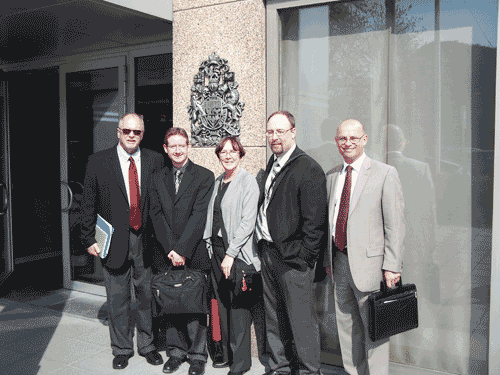Marketing mission
EXPORTING SOYBEANS TO THE EUROPEAN UNION
the european union imports approximately 13 to 14 million metric tonnes of soybeans every year – and there is still a demand for more. Canadian farmers could help to fill that demand, but need to better understand the market and the issues surrounding import requirements.
That was the focus of a recent investigative mission to Europe led by the Canadian Soybean Council and organized by the Canadian International Grains Institute (Cigi). Representatives from Grain Farmers of Ontario, the Canadian Grain Commission and Agriculture & Agri-Food Canada were also a part of the delegation. The week long program included a series of meetings with companies, processors and industry officials in the Netherlands and Belgium.
“Missions to Asia have focused on quality,” says Linda Malcolmson, Manager of Special Crops, Oilseeds & Pulses at Cigi. “But this introductory mission to Europe was more about discussing the technical solution for meeting GM tolerance levels, and the certifications needed to prove sustainability.”
Canada has steadily increased its soybean exports to the European Union over the past five years. In 2011, approximately 1.129 mmt of soybeans were shipped to the region, making Canada the fourth largest supplier behind Brazil, the United States and Paraguay. The Netherlands is the largest Canadian export market in the EU, representing 54.4 per cent of total exports, because it’s one of the biggest distribution points for other countries and a main processing hub.
There are three separate markets for soybeans in Europe. The non-GM food grade market (food), the non-GM crush market (feed) and the GM crush market (feed). The biggest competition factor for the crush market is cost, and Canadian soybeans are generally viewed as expensive compared to other countries. However, Canada is viewed as a source for better quality soybeans, with a consistent size, colour and moisture content. We’re also seen as a reliable source for specialty non-GM soybeans because of our investments in traceability.
The concern is genetically modified crops and the zero-tolerance policy that currently exists in the EU. Estimates suggest that most of the soybeans that are currently exported to Europe are non-GM, and this sensitivity could affect any potential growth in the GM-feed market for Canada.
finding a solution
“We know regulatory changes are a long process in Europe,” says Barry Senft, CEO of Grain Farmers of Ontario. “But a technical solution that includes food is hopeful for this year.”
The current technical solution for feed purposes involves a change to the interpretation of zero that allows for a 0.1 per cent tolerance for unauthorized GMOs that are waiting for approval. Several companies the delegation met with seemed to support this modification due to their need to secure supplies and minimize the risk involved with bulk handling systems.
“I think there’s going to be opportunities to expand the market for both food grade and GM soybeans,” Senft notes. “The demand is ongoing and the market is increasing. But it’s competitive, so it won’t be without our marketing efforts to reach this potential.”
Ken Hester, Senior Market Development Officer for Agriculture & Agri-Food Canada, agrees there is potential growth in the market. “Opportunities related to speciality production, such as non-GMO soybeans, will continue to remain strong in Europe given the well-established preferences from many segments of the value chain including consumers, retailers and processors.”
documenting sustainability
Another stumbling block though, is the issue of sustainability. “There are no problems with Canadian practices but we don’t have certifications in place,” says Malcolmson. Several meetings during the investigative mission focused on how important this will become for the EU market. However, it also triggered a lot of questions.
“Sustainability makes sense for growers and society, but what does sustainability mean?” asked Mark Huston, an Ontario soybean producer and director for Grain Farmers of Ontario. “In our talks there was no clear view on what the different associations consider to be sustainable. For some it was a smaller impact on the environment, for others it was higher yield.”
The retail chains and processors in Europe are leading the move to sustainability. They want to know what production practices are being used, including water usage and crop rotation. “In Ontario we view soybeans as one of the most sustainable crops, we use minimal fertilizer and do a lot of no till,” asserts Huston.
The challenge for the Canadian soybean industry is to create a certification process that will work for farmers. According to Huston, “The certification systems that are the most successful are those that are the least onerous for farmers. They need to see that it is generating revenue.”
More than half a dozen schemes for proving sustainability have already been approved by the European Union, and more than a dozen more are waiting for approval. Canada can adopt one of the existing schemes, or create its own. Malcolmson says she’s not sure what is best for Canada because, “some of the existing ones deal with issues like labour standards that aren’t a concern in Canada.” One benefit of creating a Canadian documentation system is that it could be applicable to all commodities.
The investigative mission also provided Canadian delegates the opportunity to highlight some of the production methods and traceability systems already being used by Canadian soybean producers.
“The next step,” says Senft, “is to have more discussions with different levels of government in Europe and share our perspective on food grade and GM products. We need to step up our availability to the customers and make sure they know we are providing a great product, in this case soybeans.”
pictured below from left to right: Barry Senft, CEO, Grain Farmers of Ontario; Ken Hester, Senior Market Development Officer, Grains & Oilseeds Division, Agriculture & Agri-Food Canada (AAFC); Linda Malcolmson, Manager of Special Crops Oilseeds & Pulses, Canadian International Grains Institute (Cigi); Mark Huston, ontario Soybean Producer, director, grain farmers of ontario and Randy Dennis, Chief Grain Inspector, Canadian Grain Commission (CGC)

getting to know who we met with
COCERAL is the acronym for “Comité du Commerce des céréales, aliments du bétail, oléagineux, huile d’olive, huiles et graisses et agrofournitures.” Translation – the association represents the European cereals, rice, feedstuffs, oilseeds, olive oil, oils and fats and agrosupply trade.
The association was founded in 1958. It includes the national trade organizations of most of the 27 countries of the European Union. They represent distributors, exporters, importers and agribulk storers. The members are composed of private traders and in some countries, farmers’ cooperatives. Where a national trade organization does not exist, individual companies are admitted as members.
COCERAL focuses their efforts on addressing trade barriers by advocating with government stakeholders. The association has dealt with issues relating to low level presence (LLP) policy, sustainability, the Renewable Energy Directive (RED), pesticide residues, heavy metals, and mycotoxins. www.coceral.com
FEDIOL is the federation representing the European vegetable oil and protein meal industry. It includes more than 35 companies in 17 countries. In addition to buying and transporting seeds and oils, members crush oilseeds into crude oils and meals. Members also sell oils for food, feed and energy markets and meals for the feed market. With about 150 facilities in Europe, FEDIOL members process 30 million tonnes of basic products a year. The EU industry serves the second largest world market of vegetable oils after China. www.fediol.eu. •






















